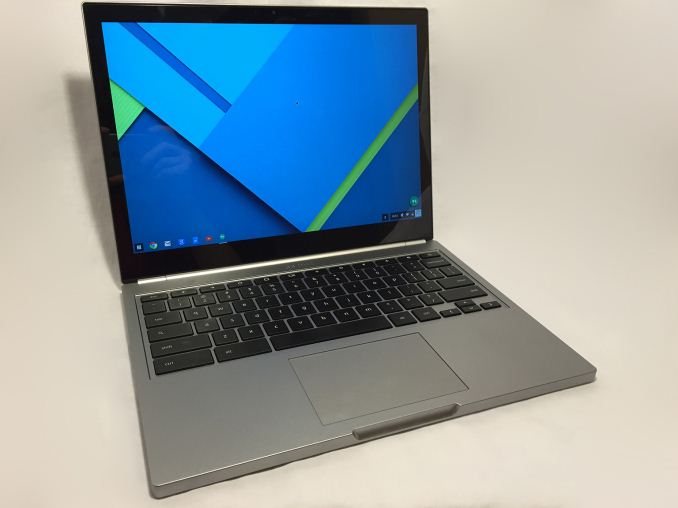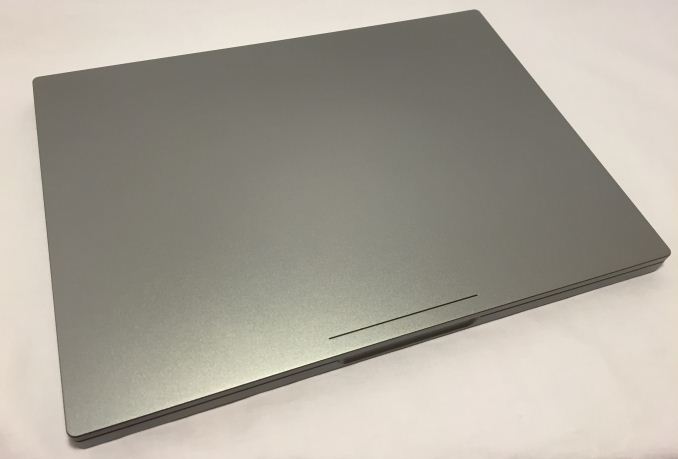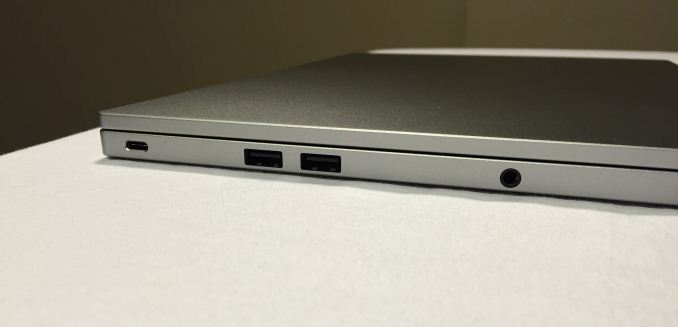The Chromebook Pixel (2015) Review
by Brandon Chester on March 16, 2015 8:00 AM EST- Posted in
- Laptops
- Chrome OS
- Chromebook
- Chromebook Pixel

Google's Chrome OS has always been similar to Microsoft Windows in how one company provides the operating system for many different manufacturers to use on their own devices. But two years ago, Google decided to create a Chromebook which was solely Google branded and designed. Although Chromebooks typically aim at the inexpensive part of the laptop market, this Google branded Chromebook had specifications that put it in line with high end Ultrabooks, and an equally high price tag. It was the original Chromebook Pixel, and its name referred to its 2560x1700 IPS display. At 239ppi it had the highest pixel density of any laptop in the world when it was released, and the rest of its specs were also impressive. In our original review of it, we concluded that it was an impressive laptop, but that its starting price of $1299 was quite a barrier to entry. In addition Chrome OS was more limited at that time than it is today.
That brings us to the new Chromebook Pixel which was released just last week. At first glance, you would be hard pressed to tell the difference between this new model and the old one. It has a similar high resolution display, and the same aluminum body with flat edges. But a look at the sides of the chassis will reveal a pair of highly versatile USB Type-C ports, and a figurative look inside will show one of Intel's new Broadwell CPUs which enables high performance and stellar battery life. Before we dive into the new Chromebook Pixel, I've compared it with the original Pixel from 2013 in the chart below.
| Chromebook Pixel (2013) | Chromebook Pixel (2015) | Chromebook Pixel LS | |
| Dimensions | 11.72 x 8.84 x 0.64" (297.7 x 224.5 x 16.3mm) | ||
| Mass | 3.35 lbs (1.52kg) | ||
| CPU | Core i5-3337U (2 cores + HT) | Core i5-5200U (2 cores + HT) | Core i7-5500U (2 cores + HT) |
| L3 Cache | 3MB | 3MB | 4MB |
| Base CPU Clock | 1.8GHz | 2.2GHz | 2.4GHz |
| Max CPU Turbo | 2.7GHz | 2.7GHz | 3.0GHz |
| GPU | Intel HD 4000 | Intel HD 5500 | Intel HD 5500 |
| System Memory | 4GB DDR3L-1600 | 8GB LPDDR3-1600 | 16GB LPDDR3-1600 |
| Storage | 32GB SSD | 32GB SSD | 64GB SSD |
| Display | 12.85" 2560x1700 IPS LCD | ||
| Battery | 59 Wh | ||
| Ports | 2 x USB 2.0, Mini DisplayPort, 3.5mm audio | 2 x USB Type-C, 2 x USB 3.0, 3.5mm audio, SD card | |
| Connectivity | 2x2 802.11a/b/g/n + BT 3.0 | 2x2 802.11a/b/g/n/ac + BT 4.0 | |
| Launch Price | $1299 | $999 | $1299 |
Some investigation into the Pixel's hardware reveals a few more details about it. The version sent by Google was the normal Intel i5 model, and although I don't expect the suppliers would be different for parts of the "Ludicrous Speed" model, it's still possible. In addition, parts like the RAM and SSD could be sourced from multiple vendors, although this is again unlikely due to the relatively small number of units that will be manufactured.
The original Pixel used a Sandisk iSSD, while this new Pixel uses an SSD made by Kingston. It's likely that it's still soldered to the motherboard which makes replacing or upgrading it impossible. Given that the Pixel can only be disassembled using suction cups and a great deal of force I'm not able to actually look inside to check. In addition, the i5 model of the Pixel uses two 4GB LPDDR3 modules which are manufactured by Samsung.
The chassis of the new Pixel is just as impressive as the previous model. The aluminum construction feels incredibly solid, and is heavy but not excessively so. When you first look at it, you'll notice that the device itself is slightly more square than other laptops, as a result of its 3:2 display. This square profile also extends to the sides and edges of the Pixel, which are as flat as can be. The top of the device also retains the LED light bar from the original model, which lights up in green, yellow, red, and blue colors and has a very Googley feel to it. Tapping twice on the top of the laptop will cause some of the LEDs on the light bar to turn on, and the color and number of LEDs gives you an approximation of how much battery life you have left. All these little details result in a really unique design, and its been clear since the original Pixel that Google wanted to create their own device instead of just carbon copying another laptop
Upon opening the Pixel, you'll be greeted by a uniquely shaped LCD display surrounded by a fairly thin bezel. Beneath it are the keyboard and touchpad, both of which felt great to use. The keyboard had a comfortable amount of key travel, very little movement back and forth, and large well spaced key caps that made typing a breeze. The keyboard also acts as the vent for the Pixel's fans, and the speakers are hidden underneath. Google uses sensors to detect when your hands are over the keys, and so the keyboard backlight is only on when you're typing. The touchpad is covered by a smooth piece of glass, and it was responsive and accurate in use, which is something that can't be said about many other laptops regardless of price. One small complaint I have is that Chrome OS doesn't seem to support pinch to zoom on the touchpad. If it does, I certainly couldn't find the option anywhere I looked.
That brings us back to the display, which is a 3:2 touch enabled IPS LCD. Chrome OS seemed reasonably responsive using the touchscreen, although much like on Android multi-touch gestures like pinch to zoom didn't track well to how your fingers were actually moving inward and outward. I don't think that the touchscreen is really a necessary input method on a laptop, and in my experience it's not comfortable in the slightest to hold your arm up and poke at your laptop display, but the option is there for users who desire it. Google has also improved the display hinge to reduce the bounce back of the display when touching it.
The sides of the pixel have all of the ports for expansion. Google clearly believes that users enjoy having ports on their laptops, and so each side of the Pixel has a USB 3.0 Type-C port, along with two USB 3.0 Type-A ports and an audio jack on the left side, and an SD card slot on the right side. Google provides several adapters that can be used to transform the Type-C ports to other existing interfaces, including HDMI, DisplayPort, and both female and male USB Type-A.
The build quality of the Chromebook Pixel certainly inspires a great deal of confidence in the rest of the machine, so lets continue our examination of the new Pixel with a look at the improvements Google has made to the display.













123 Comments
View All Comments
Sushisamurai - Monday, March 16, 2015 - link
Just nit picking, but for the battery / charge time section, I think you should add a chart for normalized values, to compare efficiency - I think it'd be neat to see how efficient these new laptops are getting (it's the new trend!)Sushisamurai - Monday, March 16, 2015 - link
But yeah, cool read. If it didn't have chrome book logo written on it, i think I might just mistake the keyboard/trackpad design for a Macbook design. The body could use some contours IMO. That LED light bar is a novel ideaandychow - Monday, March 16, 2015 - link
My only real complaint is the lack of "page-up/page-down" buttons. They had the space left and right of the "up" button. I use those a lot normally. I know you can do alt-up or alt-down, but, I would like those buttons.Otherwise, great device that fixes the only real problem with the first one: the battery life.
I can't find this on the google store, but as soon as it's there I'm buying one.
Brandon Chester - Monday, March 16, 2015 - link
Are you in the US or UK? It should be available there right now.melgross - Monday, March 16, 2015 - link
"All these little details result in a really unique design, and its been clear since the original Pixel that Google wanted to create their own device instead of just carbon copying another laptop"Well, as this looks almost exactly like a Macbook Pro to most people, I wouldn't say that it's so original. It seems that to pc makers, and now this extends to Google's Chrome efforts, being "original" means copying Apple (again).
Yes, I expect to get flamed here, but that doesn't change the facts.
Brandon Chester - Monday, March 16, 2015 - link
I have both Retina MacBook Pros and the Pixel is distinctly different in many ways.aliasfox - Monday, March 16, 2015 - link
As someone who's seen and used a variety of different MacBooks as well as the first generation Pixel, I'll say that if a Retina MacBook Pro makes the average laptop look cheap and chintzy, then the Pixel makes the rMBP look and feel like a low-effort design. The Pixels that I've handled and seen seem to have tighter tolerances and lower torsional flex than even the unibody MacBooks, which make them seem even more 'hewn from one piece of metal' than Apple's products do.In terms of look and feel, if the average laptop was a Toyota Corolla and a MacBook Pro was an Audi A6, then the Pixel is like a Mercedes Benz S-Class. It really is very noticeable.
MykeM - Tuesday, March 17, 2015 - link
Knowing Mercedes, the attention to details cover more than just the exterior design but also the engine or the engineering throughout the entire vehicle. If you look at the typical Mercedes, it would look something like this:http://i.imgur.com/DQg0bp4.jpg
Now if you look inside a Chromebook, you'll see this:
http://i.imgur.com/V9BVu2N.jpg
http://i.imgur.com/ZnK3YTJ.png
And compare it to the inside of a Retina MacBook Pro:
http://i.imgur.com/O5LcAHg.jpg
Now tell me again which of the two is the Mercedes and the Toyota Prius?
http://i.imgur.com/Ua07lwU.jpg
Braincruser - Monday, March 16, 2015 - link
This is a price range for many gaming laptops. Infinitely more powerful, better storage AND better facebook machine.MantasPakenas - Monday, March 16, 2015 - link
Nice review. However, I see a couple of glaring issues I'd like to see addressed:Even though you criticize the Pixel, even if indirectly, for running a somewhat limited OS for this price bracket, you (and to be fair, most other reviewers) fail to mention it's one huge advantage (given the limitations) - killer security features and 0 hassle with updates or almost anything else OS related. That's worth a lot to a lot of people, even if most of them look for something much cheaper.
Pardon, but I just don't see how benchmarking the Pixel against tablets and vastly cheaper and inferior Chromebooks makes any sense at all. This is, after all, an ultrabook, and one costing $1000 or more. These benchmarks give me somewhere around 10% of (somewhat) useful information, and omit the 90% of the really important one. I can understand how including one or two more powerful Chromebooks makes sense as a baseline, but this laptop has a display, battery, and processor that needs to be compared only agains Macbook Pros, Airs, Lenovo Yoga Pros and Dell XPS 13s! Especially since this is targeted at developers and these guys are more than likely to run at least Linux on it, doing most of the same tasks they would do on their Windows or OSX machines.